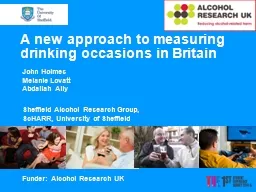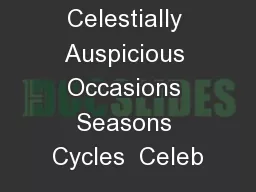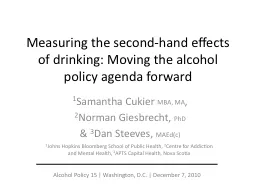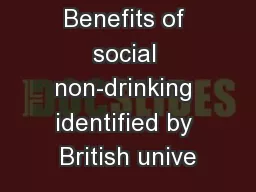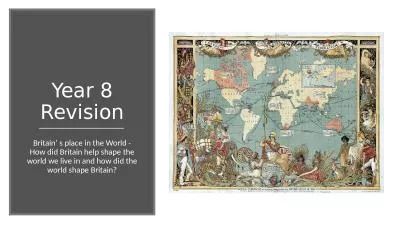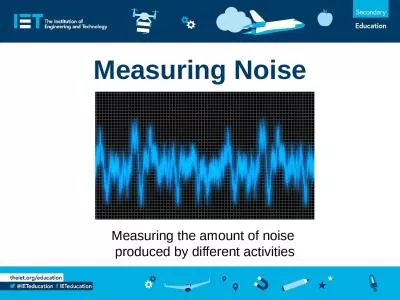PPT-A new approach to measuring drinking occasions in Britain
Author : myesha-ticknor | Published Date : 2016-06-08
John Holmes Melanie Lovatt Abdallah Ally Sheffield Alcohol Research Group ScHARR University of Sheffield Funder Alcohol Research UK Culture in the 2012 Alcohol
Presentation Embed Code
Download Presentation
Download Presentation The PPT/PDF document "A new approach to measuring drinking occ..." is the property of its rightful owner. Permission is granted to download and print the materials on this website for personal, non-commercial use only, and to display it on your personal computer provided you do not modify the materials and that you retain all copyright notices contained in the materials. By downloading content from our website, you accept the terms of this agreement.
A new approach to measuring drinking occasions in Britain: Transcript
John Holmes Melanie Lovatt Abdallah Ally Sheffield Alcohol Research Group ScHARR University of Sheffield Funder Alcohol Research UK Culture in the 2012 Alcohol Strategy A culture where it has become acceptable to be excessively drunk . How do city leaders address these challenges and measure their success This report discusses key approaches to street design projects and how results can be measured against goals for safety serving all users and creating great public spaces while a Celestially Auspicious Occasions presents a fascinating crosscultural exploration of the rites and rituals inspired by heavenly events from Valentines Day to the blue moon to connection between ancient Egyptian beliefs and Easter eggs Powered by TCP Presenters: Ms. Brandi Alford, CHES, MPH, NMCPHC. Mr. Mike . Aukerman. , NADAP Lead Program Analyst. Drinking Responsibly. Presenter: Ms. Brandi Alford, MPH, CHES. “ The views expressed in this presentation are those of the author and do not necessarily reflect the official policy or position of the Department of the Navy, Department of Defense, nor the U. S. Government.”. Speech “Genres”. “A rhetorical speech genre represents a coherent and recognized arrangement of elements in a composition or discourse that is appropriate to certain occasions and that creates audience expectations that constrain and guide a speech’s content, style, and delivery.” . 1. Samantha . Cukier. . MBA, MA. , . 2. Norman . Giesbrecht. , . PhD. . & . 3. Dan . Steeves. , . MAEd. (c). 1. Johns Hopkins Bloomberg School of Public Health, . 2. Centre for Addiction and Mental Health,. Sajan Amin. North Carolina School of . Science and Mathematics. The Problem…. An underage person doesn't realistically . consider the consequences of his or her drinking . when getting . behind the . Dominic Conroy, Postdoctoral researcher, Birkbeck University. Alcohol Research UK Early Career Symposium 4. th. April 2017. Background. Young people in the UK engage in relatively high risk alcohol consumption. Write “ALCOHOL” on your Building Resiliency page and write the notes as directed throughout the PowerPoint. (The slides will tell you when to write something down).. Alcohol affects a teen brain differently than a mature adult brain. The brain goes through rapid development and “wiring” changes during the ages of 12 and early 20s. . To provide examples of each dress code for men and women. . To interpret appropriate dress for specific occasions.. 2. Dress Codes. Include:. white tie. black tie. black tie optional. semiformal. business formal. Basically drinking a great deal of alcohol in a short period of time.. Technically - Binge . drinking is . a . pattern of alcohol consumption that brings the blood alcohol concentration (BAC) level to 0.08% or more in a short period of time. This pattern of drinking alcohol usually in less than 2 hours, corresponds to:. Year 8 - Britain’ s place in the World. How did Britain help shape the world we live in and how did the world shape Britain?. Why did the British Build and Empire?. The Empire Builder. What was their role?. What is a special occasion?. What special occasions do you celebrate? . What . is this special occasion?. What . might people eat?. Hanukah. . Jam filled doughnuts. Potato pancakes. What . is this special occasion?. .. What celebrations or festivals can you name?. The celebration may be for. :. a birth;. The celebration may be for. :. a birthday;. The celebration may be for. :. a . wedding;. an . anniversary;. The celebration may be for. produced by different activities. Stay safe. . Whether you are a scientist researching a new medicine or an engineer solving climate change, safety always comes first. An adult must always be around and supervising when doing this activity. You are responsible for:.
Download Rules Of Document
"A new approach to measuring drinking occasions in Britain"The content belongs to its owner. You may download and print it for personal use, without modification, and keep all copyright notices. By downloading, you agree to these terms.
Related Documents

